
(L to R) Professor David Serlin and Vogue critic Sarah Mower in a ‘dress to protest’ session at Port Eliot Festival, on a stage printed using Epson inkjet
Get ready for some uplifting bright florals, gothic architecture
inspired fabrics, and a sportswear jacket that does far more than meets
the eye; this month we are delving into the fashion world and the impact
of wide-format printing technology on the industry.
Having noticed the sheer amount of fashion related printing stories, we
here at Print Monthly thought it was only right to dedicate a whole
feature to the topic. The capabilities of printers these days is
certainly allowing designers to be bolder, more creative. In some cases,
bespoke handcrafted work is actually taking a backseat in favour of a
move to using printed designs. These are all made possible with the
latest technology, from printing manufacturers both yourself and I have
read about in this very magazine.
Take Epson, for example. The print giant was the chosen manufacturer for
fashion designer Richard Quinn when tasked with decorating a stage at
Port Eliot Festival, held in Cornwall in July. The festival celebrated
words, music, fashion, nature, and food. One stage, called The Wardrobe
Department, hosted interviews with design legends, and was designed and
produced by Quinn.
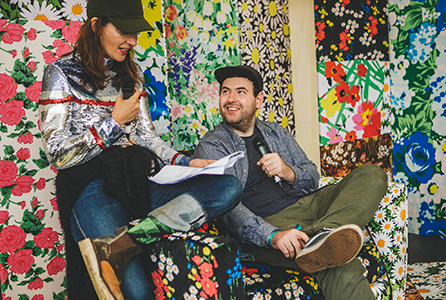
Richard Quinn on the set he designed and printed for Port Eliot Festival using Epson inkjet
In his new studio, Quinn used Epson’s Sure Color SC-F9200 to print Mylar
metallic wall coverings and Premier Textiles furniture fabric for the
festival stage. Quinn was even interviewed on stage about his new
collection to be shown later this year at London Fashion Week.
“Being invited to create a unique, one off set for the festival was such
an exciting prospect,” says Quinn, adding: “Although initially daunting
because I had to create so many appropriate surfaces and textiles for
the set, the Epson technology, its ease of use and multiple available
substrates made the task straight forward, cost effective and achievable
in a short time frame.
“My design and print is all about the colour vibrancy and the Epson
technology allowed me to get the desired Pantones with ease across all
the substrates. The Sure Color SC-F9200 has been so efficient for our
fashion line and this was the first time exploring upholstery fabrics—a
great success. The Epson option for a 4 pass plus 30 ensured the thicker
pile fabrics are as vibrant as others, making the Parker Knoll
furniture really pop.”

My design and print is all about the colour vibrancy and the Epson
technology allowed me to get the desired Pantones with ease across all
the substrates”
Richard Barrow, senior product manager at Epson Europe comments on how
more designers are seeing the capabilities of Epson technology: “It is
very exciting how Richard is exploring the considerable flexibility of
digital print to take his designs onto a wide variety of substrates. He
is leading the vanguard of new young designers who are taking advantage
of the considerable power of digital to create new opportunities and
businesses.”
High in demand
On top of this, students from Birmingham City University’s (BCU) School
of Fashion and Textiles recently demonstrated the flexibility of Epson
inkjet by producing home furnishing designs with the technology.
The Sure Color SC-F wide-format dye-sublimation printer and desktop Sure
Color SC-F2000 direct-to-fabric printer take pride of place in the
university’s digital print suite and are said to be ‘high in demand’ by
students.
Designs for items such as wallpaper, sofas, cushions, and lamps were
created using the printers and were also displayed at FESPA in Germany.
However, Epson did not just recommend the printers and leave the
students to it; the company is keen to educate the younger generation so
they can have as much success as possible. As part of the project, the
students attended a colour management workshop at Epson UK’s
headquarters to gain skills that will help them maximise the quality of
their designs.
Epson awarded Shannon Keenan, a BA (Hons) Textile Design graduate, with a
‘Creativity in Digital Print’ award for her project combining satin and
diaphanous textiles, surface embellishments, and Sure Color SC-F
digital print to produce fabrics inspired by gothic architecture.
“Working with Epson has been brilliant for the students, showing them
the skills and considerations required for commercial print production
in relation to our own fabulous facilities,” says Kate
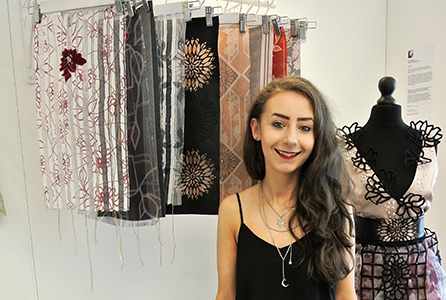
Shannon Keenan created fabrics inspired by gothic architecture using Epson’s Sure Color technology
Farley, lecturer in Textile Design at BCU, adding: “Epson’s generosity
in supporting the course in a number of ways shows how mutually
beneficial these partnerships can be.”
Heather Kendle, market development manager at Epson Europe, adds: “Since
Epson started working with BCU, we have consistently been impressed by
the quality and creativity we have seen from the students. The ability
to combine print with other elements is what came through in Shannon’s
work, as well as her attention to detail and understanding of what a
commercial brief may require.”
Opening doors
Hybrid Services, exclusive UK and Ireland distributors for Mimaki, has
spoken out on the impact Mimaki printing technology has had on the
fashion industry. The company continues to drive the digital fashion
printer sector, with many textile machine launches at this year’s FESPA.
It highlights its TS30-1300 dye-sublimation printer as the ideal entry
level solution, costing £7,495.
Brett Platt, textile product manager for Hybrid Services, says: “The
TS30 will open doors to fashion designers and studios thanks to its low
cost and ease of use. It offers unique features such as eye-catching
fluorescent inks and gives fashion professionals a tool that brings
print to life. For sampling purposes, it is no longer good enough to
present a fashion design idea on paper and the TS30 makes it
cost-effective to show compelling samples or even made up garments on a
range of different polyester fabrics.”
Platt also highlights Mimaki’s three production textile printers, the
TS300P-1800, Tx300P-1800, and Tx300P-1800B. He says: “With the 300
Series textile and dye-sublimation printers, Mimaki has the strongest
offering available and the take up from fashion companies, universities,
and design studios has been significant. The recent launch of the belt
fed Tx300P-1800B has enabled cotton jersey, very lightweight silk and
other more challenging textiles to be printed to, whilst retaining
ultrahigh print quality thanks to its stable fabric transport.”
Mimaki also launched the Tiger-1800B this year, which Platt says is
capable of bringing “fast fashion” back to the UK, for example, when
producing limited edition clothing collections.
Platt concludes: “Our printers are used by up and coming university
students to show their final year portfolios, small fashion houses to
produce one-off dresses for discerning clients, large print providers
who serve many of our high street retailers with exciting, high fashion
product lines, and global designers looking for a runway piece that will
appear in the pages of the latest magazines. As a hardware distributor,
there has never been a more exciting time to be involved in the fashion
industry.”
One establishment that has invested in Mimaki’s TX300P-1800 textile
printer is Heriot Watt University’s School of Textiles and Design. Its
25 final year Design for Textiles students were able to output designs
onto a range of fabrics for their degree show.
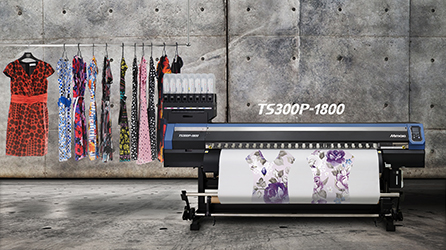
Mimaki’s TS300P-1800 printer has had significant take up from fashion companies and universities
The TX300P-1800 is a 1.8m wide textile printer which can print on
cotton, silk, wool, and polyester—providing plenty of choice for fashion
designers. The machine has a production speed of up to 55sq m/h and is
ideal for short to medium run production, especially to produce items
such as furnishings and other textiles.
“Our existing Mimaki printers have served us well for over 10 years but
with the added capacity of the new Tx300, we’re able to more efficiently
deliver the long runs required by our students for their final year
collections,” says senior technician, Dr Roger Spark.
He continues: “We offer the potential for not only the Design for
Textiles undergraduates to print their work but also the provision of
printed fabric for our Fashion students to make into garments in our
sewing workshops.”
Spark also notes how the Tx300P-1800 has fitted into their print room “perfectly”.
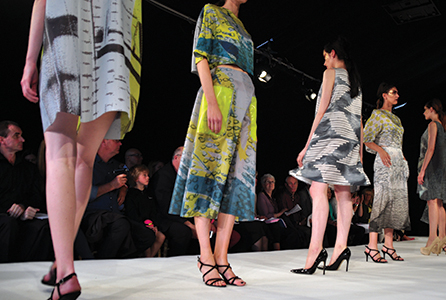
Mimaki’s TX300P-1800 textile printer was used by Heriot Watt University students in their degree show
Hybrid Services’ national sales manager, textile and apparel, Stephen
Woodall, comments on the use of the Tx300P-1800 at Heriot Watt
University: “This is one of the very first of the new printers to be
installed in a university and it’s great to see students benefiting from
the absolute latest textile printing technology. Heriot Watt’s
undergraduate textile courses offer a unique and valuable opportunity
for prospective fashion designers to experience industry standard
equipment and processes.”
Winning gold
Of course, there are many different areas of fashion, from children’s
wear to costumes. Another area is sportswear, which as a sector requires
not only style but practicality. Kayaking apparel company, Peak UK,
spent four years making its Racer ST garment by combining a jacket, life
jacket, and spraydeck into one item. The combination reduced the
thickness of the life jacket by 20 to 30mm, and reduced the overall
weight of the jacket, resulting in increased speed for canoeists.
Peak UK founder, Pete Astles, explains: “From the very early stages of
the initial idea, we knew we had a completely unique and groundbreaking
piece of kit that could give athletes the edge over their competitors.
With the Rio 2016 Olympic Games coming up, we decided to approach
British Canoeing and explore the possibility of supplying the kit for
the athletes.”
O Factoid: Port
Eliot Festival posed interesting debates about whether fashion can be
utilised as a form of protest. It showcased ‘Cancel Brexit’ t-shirts
designed by Katharine Hamnett, where proceeds from sales will support
the Cancel Brexit campaign. O
British Canoeing were won over, and entered a partnership with Peak UK
to become official suppliers of the kit at the Olympic Games. However,
having only produced prototypes of the garment by hand, Peak UK needed
to invest in technology that would allow them to put Team GB’s branding
onto the product.
Astles adds: “We were instantly drawn to the Roland DG Texart RT-640
dye-sublimation transfer printer because it was more industrial and
robust than its competitors, with the open design making it easier to
service, clean, and maintain. We quickly got to grips with the machine
and one year later, we still cannot fault it. The machine is truly
faultless, effortlessly printing high quality prints to the extent where
we have not had one bad print.”
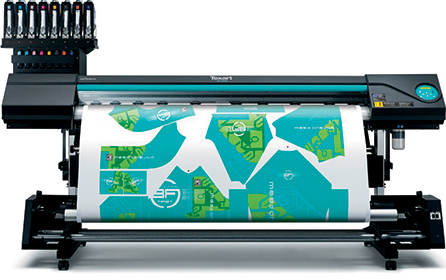
Peak UK founder, Pete Astles, says after one year with Roland DG’s Texart RT-640, he “still cannot fault it”
The Texart RT-640 from Roland DG, with its printing resolution of
1,440dpi, is said to be ideal for sublimated sportswear, soft-signage,
fabric for fashion, apparel, décor, and promotional goods.
Team GB athlete Joe Clarke, who wore the Racer ST garment at the 2016
Rio Olympic Games, went on to win the gold medal in the K1 men’s
individual. Clarke praised his thinner life jacket for providing the
“marginal gains” that made his win possible.

Peak UK created a unique sportswear jacket with the
help of Roland DG technology to add Team GB’s branding. Pictured:
Olympian, Fiona Pennie
So, wide-format printing technology is having a huge impact on fashion,
enabling designers to be more creative and even helping students in
their first steps into the fashion world. Furthermore, when designers
such as Richard Quinn are gracing the pages of both Vogue and Print
Monthly, it is clear the two worlds are closer than perhaps perceived.
Your text here...
Your text here...